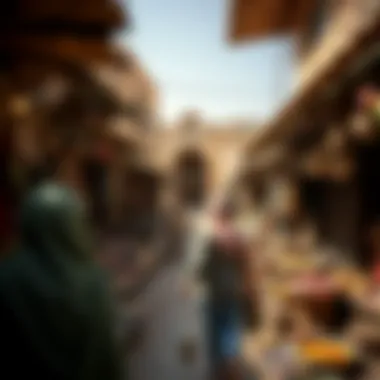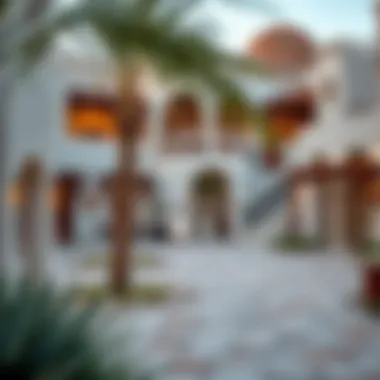Dynamics of Arabian Villages: Culture and Change


Intro
Arabian villages are often considered the heart of the culture and traditions that have thrived across the Arabian Peninsula for centuries. These villages, steeped in history, offer a glimpse into the past while simultaneously shaping the future. The story of these villages isn’t only about mud-brick houses and date palms; it intertwines with economic advancements and urbanization, particularly in vibrant cities like Dubai.
In this exploration, we will travel through the winding alleys of these traditional enclaves, unraveling their architectural wonders and understanding their place within the modern tapestry of life. From the bustle of city life to the serene landscapes of rural settings, we'll see how these villages have adapted over time without losing their essence. This narrative serves not just as a window into history but also as a guide for investors and homebuyers aiming to understand the allure and potential of real estate in these areas today.
As the pace of life continues to evolve, so do the needs and desires of those drawn to these quaint communities. Through an examination of current market trends and investment strategies, we can better appreciate how Arabian villages hold value beyond their picturesque scenes.
Cultural Heritage of Arabian Villages
The cultural heritage of Arabian villages is a vital aspect of the narrative that shapes the identity of the people living in these areas. It carries the stories of the past, interwoven with the traditions and customs that define daily life. Every village is like a mosaic, where each tile adds depth and meaning. The essence of these cultures lies in their rich histories, the arts they produce, the social frameworks they uphold, and the languages and stories shared through generations.
Historical Context
Origins of Arabian Villages
The origins of Arabian villages can be traced back through centuries, when tribes began to settle rather than roam, establishing root in fertile lands. These settlements often emerged around oases or water sources, where agriculture became a primary source of sustenance. The key characteristic of these origins is the inherent adaptability of the communities; they learned to thrive in a tough environment, crafting intricate irrigation systems that changed the landscape. Cultural practices from these times heavily influence traditions today.
One unique feature of these origins is the blend of indigenous customs with influences brought by trade routes that connected diverse cultures. The advantages of understanding this historical backdrop lie in recognizing how intertwined human innovation and resilience are with the ways of life still observed in these villages. However, one potential disadvantage is that modern developments sometimes overshadow these deep-rooted traditions, causing a risk of cultural dilution.
Impact of Nomadic Tribes
The impact of nomadic tribes on the development of Arabian villages is profound. These tribes brought with them a rich tapestry of customs and a wealth of knowledge about the land. They were the original caretakers of the desert, and their transient lifestyles taught them to utilize resources efficiently. One defining characteristic of the influence of these tribes is their ability to foster community ties that withstand the rigors of migration.
Emphasizing oral traditions and collective memory, nomadic tribes contributed significantly to the identity of Arabian villages. For instance, the storytelling techniques they practiced are still evident in village life today. The unique feature of their impact is evident in the communal gatherings and cultural practices that have persisted even as communities settled. While this heritage is beneficial in creating a robust social fabric, the evolving societal context sometimes challenges the continuation of these traditions, making it imperative for modern villagers to navigate heritage preservation alongside changing realities.
Art and Traditions
Folk Art and Craftsmanship
The folk art and craftsmanship found in Arabian villages is more than just aesthetic; it serves as a visual storytelling mechanism that encapsulates the values, beliefs, and history of the community. Artisans pass down their skills through generations, creating vibrant textiles, intricate pottery, and beautiful calligraphy that reflect local themes. The craftsmanship often embodies practicality, marrying utility with beauty in everyday objects.
A key characteristic of this folk art is its connection to the natural environment, using local materials and traditional techniques that have stood the test of time. This authentic craftsmanship resonates with both locals and tourists, making it a cherished aspect of cultural identity. However, while these art forms represent a strong tradition, the market dynamics can sometimes impose pressures for commercialization, risking the authenticity that drew admiration in the first place.
Festivals and Celebrations
Festivals and celebrations in Arabian villages provide community members with a chance to come together in joy and reflection. Each event often ties back to the agricultural cycle, marking important seasonal changes or historical events. The vibrant colors, spirited performances, and communal feasting create a tapestry of shared experiences that foster unity.
The unique feature of these festivals lies in their inclusive nature; they often bridge age gaps, allowing the young to learn from the elders. With vivid traditions being showcased through music, dance, and storytelling, these events underline communal identity and solidify social bonds. Yet, the challenge remains of adapting these celebrations in a way that attracts younger generations while keeping the core traditions alive.
Language and Storytelling
Oral Traditions
Oral traditions are the lifeblood of Arabian village culture, serving as vehicles for preserving history and values. Stories are shared by families around communal fires, each tale woven with morals and reflections from daily life. Their power lies in the vivid imagery and emotional connections they foster, making memories come alive. This uniqueness ensures that even without formal education, knowledge is passed down, enriched and adapted through succession.
The achievement of these oral traditions is not just their longevity but how they continuously evolve while retaining a core of wisdom. However, a disadvantage lies in the risk of losing these traditions to modern distractions; the digital age can disrupt the practices of gathering and sharing these stories.
Role of Poetry
The role of poetry in the Arabian village context cannot be overstated. Poetry encapsulates emotion, history, and social commentary in a concise format, often transmitted through both formal events and casual gatherings. Poets are revered figures, carrying the responsibility of expressing communal sentiments while reflecting the experiences of daily life.
One particular characteristic is the use of poetic forms that blend rhythm and rhyme, creating an auditory experience that captivates listeners. As a result, poetry serves not only as an art form but as a vital communication tool that ignites imagination. Yet, challenges arise as evolving language and modern narratives can sometimes overshadow the traditional styles, necessitating conscious efforts to maintain the craft's integrity.
Architectural Styles of Arabian Villages
The architectural styles of Arabian villages are not just a matter of aesthetics; they encapsulate the rich history and culture of the region, serving as a visual narrative of the people who inhabit these lands. Each structure tells a story, reflecting the unique environmental challenges, available materials, and socio-economic conditions of the time. The melding of traditional designs with modern trends further enhances the identity of these villages, making this topic essential for understanding the broader spectrum of Arabian life.
Traditional Designs
Materials Used
When it comes to materials used in traditional Arabian village architecture, mud, stone, and palm fronds stand out. These materials are often locally sourced, which aligns with both cultural practices and practical needs. Mud, for instance, is abundant and provides excellent insulation against the scorching desert heat. It’s a choice that has lasted through generations because it meets the climatic needs effectively.
A unique feature of using palm fronds is their flexibility, allowing builders to create intricate designs while also offering natural ventilation. However, one downside is the susceptibility of these materials to decay over time, which poses challenges for preservation. Such factors emphasize the need to strike a balance between historical integrity and modernization when considering architectural styles.


Environmental Adaptations
Environmental adaptations in Arabian village architecture shimmer as a testament to ingenuity. Traditional designs often incorporate high ceilings and thick walls, serving as natural air conditioning in an otherwise sweltering climate. This architectural choice reflects a keen understanding of local environmental conditions, creating spaces that are both functional and comfortable.
One of the beneficial aspects of these adaptations is their sustainability, as they rely on natural cooling rather than energy-consuming systems. However, with the rise of contemporary building practices, there’s a growing tension between maintaining these traditional adaptations and the push for more energy-efficient, modern solutions. The challenge lies in harmonizing the old with the new, ensuring that environmental considerations remain paramount.
Contemporary Adaptations
Sustainable Architecture
Sustainable architecture is increasingly becoming a focal point in discussions about Arabian village structures. Utilizing modern techniques and eco-friendly materials can preserve the essence of traditional designs while addressing contemporary environmental challenges. Green roofs, solar panels, and rainwater harvesting systems are prime examples of how sustainability is making headway into these settings.
The popularity of sustainable architecture lies in its ability to not only minimize ecological footprints but also to provide long-term savings on utility costs for residents. One unique feature is the integration of natural landscapes into architectural designs, which enhances the community's overall aesthetic. That said, sustainability often comes at a higher initial investment, presenting a dilemma for many villagers looking to modernize.
Incorporating Modern Amenities
Incorporating modern amenities into traditional Arabian village architecture involves thoughtful planning and execution. Functions like indoor plumbing and air conditioning can transform the daily lives of residents by enhancing comfort without compromising the village's cultural integrity. Designed thoughtfully, these features can blend seamlessly with the traditional aesthetic.
An advantage of this integration is the enhanced quality of life for individuals who may have previously lacked access to such conveniences. However, there's a risk that over-modernization could lead to the loss of cultural identity and community cohesion. Residents must navigate this tightrope, looking for ways to enjoy modern comforts while still honoring their rich heritage.
Influence of Urban Development
Transitional Spaces
Transitional spaces play a crucial role in shaping the relationship between traditional Arabian villages and urban development. These areas serve as buffers between the historical core of the village and the encroaching urban sprawl, allowing for a gradual blending of old and new. Such spaces are essential for preserving cultural heritage while accommodating new residents seeking the charm of village life.
One key characteristic of transitional spaces is their design flexibility, which allows for adaptive reuse of existing structures. This can result in unique, multi-functional areas that serve community needs and enhance social cohesion. However, regulatory challenges often pose limitations, preventing optimal development of these transitional zones.
Integration with Modern Infrastructure
The integration of modern infrastructure into Arabian villages epitomizes the balancing act necessary for successful development. This process involves upgrading roads, utilities, and communication systems to meet contemporary needs without disrupting the village's historical fabric. It can contribute to economic growth while enriching the quality of life for residents.
The utility of seamless integration cannot be understated; it can better connect villages to larger urban centers, fostering economic opportunities for the villagers. Yet, this evolution is fraught with challenges, particularly regarding how the essence of village life is maintained amidst rapid change. Careful planning is needed to ensure that progress does not overshadow cultural values.
In summary, the architectural styles of Arabian villages offer a rich tapestry of history and modernity. They reveal the intricate dance between tradition and innovation that defines the Arabian Peninsula, providing a roadmap for the future as these villages continue to adapt and grow.
By understanding these architectural dynamics, investors, realtors, and homebuyers can gain insights that extend beyond mere visuals; they can appreciate the cultural significance and socio-economic implications that come with the territory.
Social Structure in Arabian Villages
The social fabric of Arabian villages captivates with its deep-rooted traditions and intricate dynamics. Understanding the social structure reveals not simply how communities operate but also how they adapt amidst the changing sands of time. In the context of this article, the social dynamics are pivotal—it highlights the interplay of age-old customs with the pressures of modernity, offering insight to investors and planners alike.
Community Dynamics
Roles and Responsibilities
In any village, each member plays a vital part in a larger puzzle. The roles and responsibilities within Arabian villages are often clearly defined, reflecting cultural heritage and communal values. Elders may shoulder the mantle of leadership, while the youth take charge of agricultural tasks or trade. This generational handover is a significant point; it fosters unity and facilitates skills transfer. One might observe how elders settle disputes or introduce cultural practices that youngsters might overlook.
The arrangement is not merely practical; it enriches social ties, creating a safety net of relationships. A disadvantage, however, exists in the rigidness of such structures. Occasionally, younger generations find the weight of tradition burdensome, especially when aspiring for innovation. The challenge lies in maintaining respect for roles without stifling personal aspirations.
Decision-Making Processes
When it comes to decision-making, Arabian villages often employ a consensus-based approach. Community gatherings serve as forums where various views are aired. This promotes inclusivity, particularly in matters relating to communal resources. The decision often reflects collective wisdom, balancing individual rights with communal needs. However, the drawback can be sluggishness in reaching conclusions; conflicting opinions may delay progress.
Notably, the clan system can heavily influence these processes, where decisions may be swayed by familial loyalty at times. While this strengthens bonds within families, it also poses challenges, as decisions could favor certain factions over the collective good.
Family Structures
Family structures provide another layer of depth to the social makeup of Arabian villages. Understanding these frameworks is critical for grasping how communities engage with each other and external societal shifts.
Patriarchal Systems
At the heart of many Arabian villages patriarchal systems flourish. Traditionally, men take on the roles of heads of households, guiding decisions from familial to financial. This age-old practice emphasizes the importance of male leadership in matters of inheritance and land ownership, anchoring families within the broader fabric of the village.
This system does come with its own complexities. One evident advantage is stability—it provides a clear line of authority, which can be reassuring in communal settings. However, it may also limit women's roles, often confining them to domestic spheres. This reality propels discussions on gender and equality, as younger generations call for more inclusive practices, bridging tradition with modern norms.


Tradition vs. Modernity
The ongoing tension between tradition and modernity in Arabian villages cannot be ignored. Here, one often sees colorful traditional dress juxtaposed with the allure of new technology. Elders might advocate for preserving established customs, while the youth crave contemporary influences that promise greater opportunity.
This dynamic creates an intriguing landscape. For example, traditional ceremonies might integrate modern elements like digital invitations, representing a blend of both worlds. The conflict here creates rich dialogue about identity and community. While modernity offers economic advancement, it can threaten the integrity of age-old traditions.
"In every twist of modernity, the echoes of our past remind us of who we are."
Through understanding these social structures, stakeholders can appreciate how Arabian villages are navigating the balance of welcoming progress while respecting their robust heritage. Investors and community planners would do well to recognize these dynamics, as they can influence decision-making from economic models to urban developments, shaping the futures of these culturally rich locales.
Economic Factors Impacting Arabian Villages
Understanding the economic fabric of Arabian villages is vital in grasping how these communities function and adapt within the broader regional economy. Economic stability in these villages generally revolves around key pillars such as local agricultural practices and traditional craftsmanship. These elements are not just central to sustenance; they embody the cultural identity and heritage that form the backbone of these settlements. As we dissect the economic factors, we see that both opportunities and challenges emerge, reshaping the landscape of village life.
Local Economies
Agricultural Practices
Agricultural practices in Arabian villages are diverse, with each region employing methods suited to their particular climate and geography. Traditional farming techniques, like date palm cultivation and oasis gardening, exemplify how villagers have adapted to some environmental restrictions. These practices not only provide food security but also sustain the local economy, serving both domestic needs and export markets. The focusing on organic farming is a rising trend, aligning well with contemporary consumers' demand for eco-friendly products.
One key characteristic of these agricultural practices is their reliance on family labor. Villagers often work together as a community to plant and harvest crops. This not only sustains participation but enhances social ties, making agriculture an integral part of village life, both economically and socially. While the method plays a critical role, there are disadvantages as well. Water scarcity and changing climatic conditions pose significant threats to agricultural viability, prompting some innovative adaptations but also creating uncertainty in livelihoods.
Trade and Craftsmanship
Trade and craftsmanship represent another critical economic driver for Arabian villages. Artisanal crafts, from intricately woven textiles to hand-carved wooden furniture, provide a unique economic avenue and maintain cultural traditions. These skills are often passed down through generations, creating a strong sense of identity within the community. Local markets help artisans display and sell their work, fostering a micro-economy that supports both local artists and consumers seeking authentic products.
However, trade enters a complex arena when faced with global competition and the modern retail landscape. While traditional craftsmanship can be more sustainable, they often lack the scale and reach of larger, mass-produced alternatives. This puts artisans in a difficult position where, they must balance maintaining tradition with adapting to changing consumer demands—a tightrope walk of sorts that can dictate their survival.
Impact of Tourism
Balancing Tradition and Progress
Tourism brings a dual-edged sword for Arabian villages, offering both benefits and challenges. On one hand, it serves as a critical source of income, increasing demand for cultural experiences, local products, and hospitality. Visitors flock to experience authentic cultural offerings, which, if managed correctly, can enhance the local economy and encourage the preservation of traditions. However, the influx of tourists can sometimes lead to pressure on local resources and a potential dilution of cultural practices as villages modify their offerings to cater to outsiders.
The unique feature of this balancing act is its unpredictability. What thrives under one tourism cycle may not work well in another, meaning that community leaders need to make decisions carefully. It’s a constant juggling act—promoting economic benefits while ensuring the integrity of the village's identity remains intact.
Opportunities and Threats
The tourism sector presents both opportunities and threats for Arabian villages. On the opportunity side, expanding tourism can lead to job creation, improved local infrastructure, and increased global exposure. Initiatives might include cultural festivals, art exhibits, or food fairs that connect visitors with the essence of these communities.
Yet, there are undeniable threats as well. Increased commercialization can result in gentrification, pushing out original inhabitants in favor of more profitable developments. Moreover, if tourism isn’t managed sustainably, it can damage the very traditions that draw tourists. Villagers may find themselves at a crossroads—left to navigate economic benefits while preserving their cultural heart.
"A successful village isn’t just about economic transactions; it's about weaving tradition into the fabric of progress."
In summary, understanding the economic factors impacting Arabian villages provides insight into how these communities adapt and thrive or struggle in the face of change. From agriculture and craftsmanship to tourism dynamics, each layer offers a glimpse into the resilience and richness of life in these storied villages.
Real Estate Landscape in Arabian Villages
The real estate landscape in Arabian villages presents a complex interplay between tradition and modernity. As cities expand and the demand for housing grows, these villages are increasingly finding themselves at the crossroads of rapid development and cultural preservation. The significance of this topic lies in its potential to elucidate how real estate dynamics affect not only economic growth but also community identity and heritage.
Market Trends
Property Prices
Property prices in Arabian villages fluctuate widely due to various influences, including demand, location, and historical value. One notable aspect of these property prices is their ability to attract buyers who seek a blend of cultural authenticity and modern amenities. These villages often command lower prices compared to urban centers, making them an appealing option for investors. For instance, a charming traditional home in a village may sell for a fraction of the cost of a similar property in a bustling city like Dubai.
However, property prices also face challenges. The unique feature of Arabian village properties lies in their architectural styles, often reflecting local heritage. This aspect can be both an advantage and a disadvantage; while it draws interest, it can also limit the marketability to a broader audience unfamiliar with cultural nuances.
Investment Potential
The investment potential in Arabian villages is particularly compelling, reflecting both cultural richness and economic opportunity. As urbanization spreads, these areas are increasingly sought after by investors looking for properties that offer a glimpse into the region's heritage while still providing a framework for modern living. Investors often recognize the key characteristic of these properties: they embody a sense of community that is increasingly rare in urban environments.
A unique feature of this investment potential is the possibility for adaptive reuse. Existing structures can be renovated into boutique hotels or cultural centers, providing not just a return on investment but also helping to preserve the village's identity. However, investors must navigate the challenges posed by fluctuating demand; while interest may rise, economic downturns can dampen enthusiasm, prompting caution.
Regulatory Considerations


Land Ownership Laws
Understanding the land ownership laws is essential for anyone considering investment in Arabian villages. These laws dictate who can buy property and under what circumstances. A key characteristic of land ownership laws in the region is their emphasis on local heritage. For instance, certain areas might require that changes to properties align with traditional architectural styles to maintain their cultural integrity.
The unique feature of these laws is their dual role — they protect the heritage of the village while also posing barriers to investors. Such regulations ensure that development is thoughtful and deliberate, fostering a sense of pride in the community while also supporting economic viability.
Zoning Regulations
Zoning regulations further complicate the real estate landscape in Arabian villages. These rules govern how land can be used and what types of buildings can be constructed. A critical aspect of zoning regulations is their potential to balance development with cultural preservation. For example, some areas may be zoned strictly for residential use, preventing commercial development that could disrupt village life.
The unique feature of zoning regulations is their adaptability. In some instances, village leaders can advocate for changes that reflect the community’s desires, such as allowing for eco-friendly guesthouses that attract tourists without compromising the village’s character. However, navigating these regulations can be a daunting task for newcomers, often requiring a deep understanding of local customs and expectations.
As Arabian villages continue balancing their rich heritage with the pressures of modernization, the real estate landscape remains a focal point for understanding these dynamics. It presents opportunities for investment while also necessitating a careful consideration of legal frameworks that govern land use and ownership.
Future Prospects for Arabian Villages
The future of Arabian villages holds both challenges and opportunities. It's a critical topic for understanding how these unique cultural and social spaces can thrive amidst globalization and rapid urbanization. Exploring future prospects involves examining cultural preservation, innovations, and sustainability—elements that can enhance their relevance and vitality.
Cultural Preservation
Initiatives and Programs
Various initiatives and programs aim to bolster the cultural fabric of Arabian villages. These programs are crafted to protect heritage sites, promote local crafts, and bolster community identity. One notable initiative is the safeguarding of traditional arts, such as weaving or pottery, through workshops and grants.
The key characteristic of these initiatives is their focus on grassroots participation. Villagers often lead these efforts, ensuring they reflect the community's values and motivations. This makes cultural preservation a popular choice, as it fosters community pride and local involvement.
A unique feature is the collaboration between local artists and heritage organizations. However, challenges arise when resources are scarce or technical knowledge is lacking among the older generation. Still, the benefits often outweigh the drawbacks, as these programs can rekindle interest in local traditions among youth.
Role of Government
The role of government is pivotal in shaping the future of Arabian villages. Through policies and regulations, governments can either foster cultural preservation or let it dwindle. Government support, through funding for cultural festivals or registration of heritage sites, is critically important. It reflects a commitment to preserving the unique identities of these communities.
Notably, engaging with local leaders reinforces community ties and enhances implementation efficiency. Such support is a beneficial choice for ensuring sustainability in the long run.
Yet, there are potential drawbacks. Excessive bureaucratic procedures can stall progress or limit funding to only certain recognized projects. Despite this, effective partnerships between the government and community stakeholders can significantly enhance outcomes.
Innovations and Sustainability
Smart Village Concepts
Smart village concepts represent a significant leap toward enhancing the livability and sustainability of Arabian villages. These ideas often integrate technology to improve infrastructure and connectivity while respecting traditional lifestyles. Examples include eco-friendly waste management solutions and solar energy utilization.
The key characteristic of smart village concepts is their emphasis on interconnectivity; they link community members with resources while also fostering communication and innovation. This is a beneficial strategy as it encourages economic growth and attracts younger residents.
A unique feature is the use of mobile applications that facilitate access to services like agriculture tips or market info. However, the challenge lies in ensuring technological adoption among older populations who might be less familiar with these tools.
Community Engagement
Community engagement is crucial for the sustainable future of Arabian villages. It involves creating platforms for villagers to express their needs and aspirations actively. Such engagement can manifest through local councils or village meetings, where everyone has a voice, ensuring decisions reflect the community’s desires.
The key characteristic of community engagement is its inclusiveness, bringing together diverse groups in the decision-making process. This is often regarded as a powerful tool for generating innovative solutions that honor traditional values while addressing current issues.
However, it is not without challenges. Often, participatory efforts can be hampered by a lack of trust in leadership or previous experiences that may have left communities feeling unheard. Still, the advantages of fostering an engaged community often lead to inventive approaches to local issues—creating a more resilient and coherent village identity.
These future prospects underscore the necessity of balancing innovation with cultural preservation, providing a roadmap for Arabian villages as they navigate the complexities of the 21st century.
In sum, the trajectory of Arabian villages hinges on how effectively all stakeholders- from government and local leaders to residents- can mobilize resources for sustainable growth while safeguarding their unique heritage.
Epilogue
In closing, the nuanced dynamics of Arabian villages offers a compelling narrative that intertwines history, culture, architecture, and modern-day realities. Understanding these villages is not just about appreciating their aesthetic value or historical roots; it involves recognizing their relevance in today’s rapidly changing urban landscape. For potential investors, realtors, and homebuyers, these villages serve as critical nodes where tradition meets modernity.
Reflection on Arabian Villages
As we reflect on the significance of Arabian villages, it’s essential to acknowledge their dual role as cultural repositories and evolving communities. These villages provide a window into the lifestyle, values, and enduring traditions of the Arabian populace. They serve as a vivid reminder that even in a world increasingly driven by technology and rapid development, there exists a place where the past remains relevant.
- Cultural Repository: Arabian villages are treasure troves of folklore, artistry, and craftsmanship, contributing immensely to the cultural fabric of the region. They foster community gatherings and traditional celebrations, like the Majlis gatherings that promote social ties.
- Economic Contributors: With a growing interest in sustainable tourism, these villages present both challenges and opportunities. The balance of protecting cultural heritage while allowing for economic growth is delicate yet essential.
- Historical Significance: Each village tells a story, often informed by layers of history—be it through ancient trade routes or interactions with nomadic tribes. These narratives add depth to real estate conversations, enriching the value of properties rooted in centuries-old traditions.
"The beauty of Arabian villages lies not just in their physical structure but in the lives they encompass and the stories that resonate through generations."
The discussion about Arabian villages culminates in a broader conversation about identity, place, and the future. As we integrate urban developments with these timeless spaces, the key lies in preserving the essence of each village while embracing innovation and change. Investors and homeowners should seek not merely property but a connection to a culture that has thrived against the odds. This journey through time and change underscores that our understanding of these villages will continue to evolve, making them a fascinating subject for anyone interested in the rich tapestry of Arabian life.
Overall, the exploration of Arabian villages extends beyond just an exploration of their current state. It calls for a deeper understanding of what they have to offer for the future, merging the charm of tradition with the aspirations of modern living.











